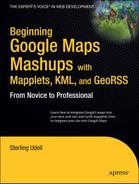Book Description
Beginning Google Maps Mashups with Mapplets, KML, and GeoRSS is a beginner's guide to creating web mashups using Google mapping technology.
Serves as a single–source primer to displaying data on Google Maps
Covers both Mapplets and the Google Maps API
Provides everything you need to start participating in the geographic Web
What you'll learn
"Mash up" GeoWeb services onto a Google map
Package your mashup as a mapplet and publish it to maps.google.com
Enhance your map with driving directions, local search, map advertising, and more
Discover common Google–mapping mistakes to avoid
Find out how and when to geocode existing data into mappable coordinates
Deliver your own data as GeoXML
Who this book is for
This book is for web designers and developers who have not worked with Google Maps or geographic data before. A working knowledge of HTML is required, and some programming experience is beneficial.
Table of Contents
- Title Page
- Dedication
- Contents at a Glance
- Contents
- About the Author
- About the Technical Reviewer
- Acknowledgments
- Introduction
- PART 1: The Geoweb and the Google Maps API
- PART 2: Mashing Up Google Maps with Mapplets
- PART 3: Ready for the Big Leagues
- PART 4: Appendixes
- Index
